Business challenges
This design challenge was critical for us due to its potential to significantly impact business outcomes. By improving the customer journey we aimed to expand companys market reach, and improve overall sales and after-sales efficiency.

Provide Personalized Experience
Create separate pathways for different buyer personas company generate more pre-qualified leads.
Reduce Lead-to-Sale Time
Shorten the sales cycle, in this case moving from how leads are acquired and pre-qualified to how a product or service is purchased
Improve Customer Satisfaction
Implement strategies to attract and capture leads that are more likely to convert into customers.
Reduce Number of Support Cases
Reduce dependence on support teams for basic and unnecessary inquires.
Improve Cross & Upselling
Enable better cross-selling and upselling by utilizing user behavior data.
Enhance Customer Lifetime Value
Decrease service costs, and enhance customer loyalty in the long term.
Driving Digital Transformation for
Industrial Solutions.

Design challenges
The main challenge was navigating the complexity of the company’s robotics ecosystem and addressing the diverse needs of its B2B customers.
Our goal was to understand this environment, define key customer personas, and map their journeys. This involved analyzing decentralized sales processes, a broad product portfolio, and customer interactions, supported by extensive documentation review.

- 01Reduce dependence on support teams for basic and unnecessary inquires.
- 02Conducting a audit of business operations and existing digital assets.
- 03Create a website that meets current needs and adapts to future trends, personalizing the customer journey.
- 04Create a website that meets current needs and adapts to future trends, personalizing the customer journey.
Project Timeline

Understanding phase and Product definition
Our journey began with an intensive workshop with key business stakeholders to understand the context and business complexity, utilizing a variety of workshop methodologies.

Business model canvas
Structuring the current business model.

Current State
Defining the project’s current state and operational processes.

Pain Points and Gaps
Identifying pain points and gaps in the current process.
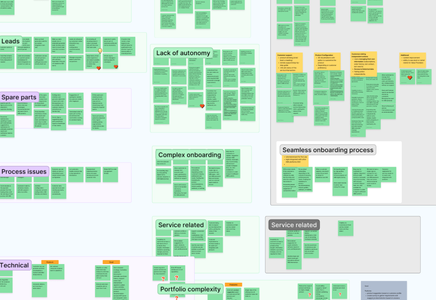
Desired state
Specifying vision for solving identified problems.

Analysis of Research and Information Overload
During the workshops, we faced the humbling realization that
“we knew nothing”. Many questions remained unanswered, highlighting the company complexity and decentralization. We distilled this information into high-level desired needs, identifying the “Client Hub” and “Marketplace” as two main components for the portal.
We also understood client buyer personas based on the preliminary documentation, which would guide our design process.
The overwhelming amount of information required significant analysis to pinpoint what would directly impact the product. we summed it into a list of specific problems and potential solutions, aligning with the issues highlighted during the workshop. We decided to continue with next workshop sessions to gather all ideas and create specific user stories.
Competitors benchmark and B2B market Insights
In between workshops, we conducted a competitive benchmark to understand the competition. We also expanded our knowledge of the Industrial robotics market, which helped us to understand our client’s specific B2B needs.
Created detailed ideas for the portal, creating input for business analysts through a list of user stories.
Collaborate with sales, marketing and product teams to detail the sales process and product catalog structure.
Understand the use of marketing and sales tools, CRM systems, and the type of data they store.
Gather customer and internal pain points, from sales people which directly interact with clients.
Product Ideation
The second workshop focused on translating broad ideas and problems into concrete, implementable solutions. After the first workshop, we had a solid understanding of the business perspective of the product and were able to move on to gathering feedback and then analyzing sales/marketing processes.

Business model canvas
Structuring the current business model.

Current State
Defining the project’s current state and operational processes.
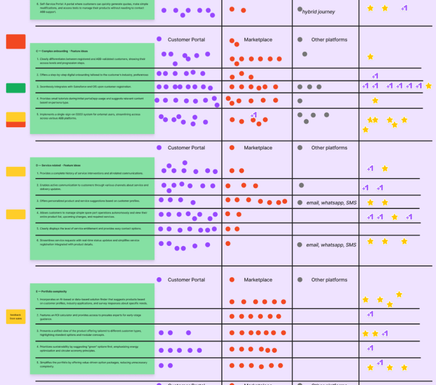
Pain Points and Gaps
Identifying pain points and gaps in the current process.
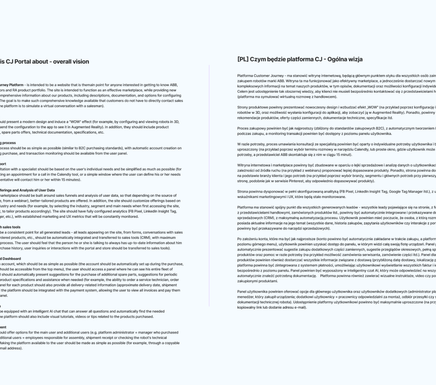
Desired state
Specifying vision for solving identified problems.
Series of Three Workshops - Sales, Marketing, Product & Pricing
The third phase of our process split into three distinct meetings involving teams from sales, marketing, and product & pricing across various countries.
First session - Sales Process Mapping
In this session, our main goal was to lay out the entire sales and marketing process, from lead generation to product delivery. We encountered:
- Complex and varied local-level (dffrent countries) processes, yet identified common steps applicable universally.
- Numerous arising pain points at each process stage were noted for further analysis.
- An overwhelming amount of information, including insights from tools like Salesforce and internal communication platforms, which required thorough review.

Second Meeting - Marketing Teams Engagement
The objective here was to validate the sales process outlined previously and to dive deeper into the robotic-solution environment by:
- Identifying problems and challenges for previously created buyer personas.
- Compiling a list of customer quotes hinting at pain points and insights.
- Recognizing internal challenges faced by sales and marketing teams daily.
- Determining the unique selling points of our products and establishing key messages for the portal’s communication strategy.

Third Session - Products & Pricing Strategies
Engaging with product and pricing teams, we aimed to understand the complexities of B2B robotics sales, including:
- Thousands of potential product configurations tailored for different industries.
- Detailed understanding of how products are sold and priced.

Summary and Key Insights:
Local teams across different countries have separate marketing funnels, landing pages, and content strategies, leading to a decentralized approach.
Each local team uses different marketing providers, though all are required to use the same CRM system, which presents both benefits and challenges.
Target customers often struggle to understand the product portfolio due to its complexity and the multitude of dependencies.
Over 1100 accessories can be customized in product selection, adding to complexity.
Sales conversations are intricate and multi-staged, frequently involving engineers from both sides due to the technical nature of the products.
We discovered an process involving client’s market partners that we had not initially considered in this case. By carefully analysing the procedures, we realised their significant role in sales.
Significant issues were identified in lead distribution to partners.
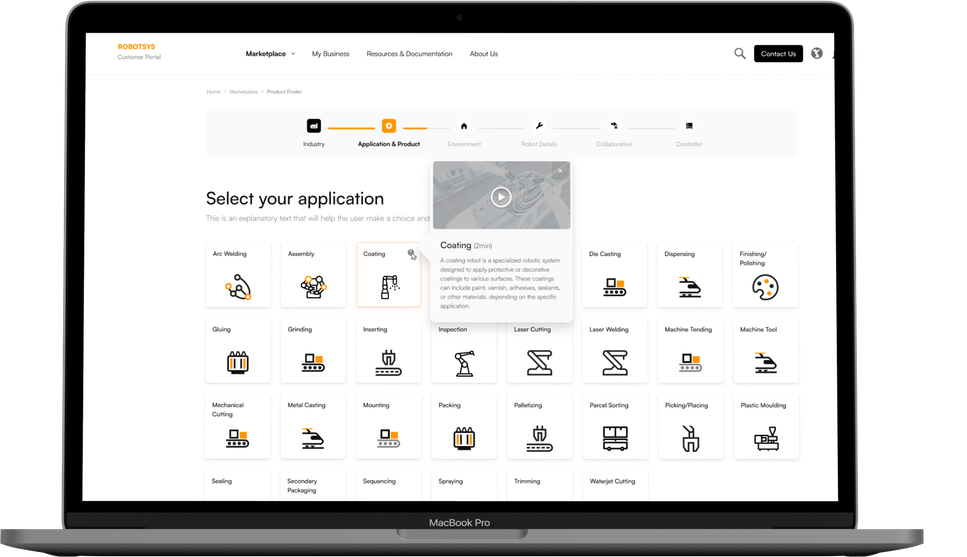
Painpoints and Solutions
Throughout the entire research phase, we and our client discovered many potential issues, which we then addressed during the design phase. Here are some them:
Target customers often struggle to understand the product portfolio due to its complexity and the multitude of dependencies.
Over 1100 accessories can be customized in product selection, adding to complexity.
Target customers often struggle to understand the product portfolio due to its complexity and the multitude of dependencies.
Local teams across different countries have separate marketing funnels, landing pages, and content strategies, leading to a decentralized approach.
Sales conversations are intricate and multi-staged, frequently involving engineers from both sides due to the technical nature of the products.
On the basis of A/B tests (on the old version of the webshop), Together with stakeholders, we decided to separate the content for logged-in and non-logged-in users, due to complex nature of the sales process.
We discovered an additional process involving client’s partners that we had not initially considered in this case. By carefully analysing the procedures, we realised their significant role.
Significant issues were identified in lead distribution to partners.
At some stage of the project, our team received a request to start additional activities in a related project. We were surprised, because it turned out that the second project fit very well with what we had already designed over the previous months in the Customer Journey portal. After discussions with both teams, we came to the conclusion that these portals should be as consistent as possible on several stages, and the partner portal itself should be an additional, dedicated component of the Customer Portal.
Discovery Phase Finalization
Due to the short deadline, we abandoned the wireframes/low-fidelity creation, jumping straight from ideas to high-fidelity to validate what is being created as quickly as possible, and contunuing by creating mockups iteratively so that we can clarify certain elements of the design with engineers and business stakeholders on real examples and data rather than abstract ones.


Design sprints
The process of designing mockups was based on weekly design sprints. In parallel, while building mock-ups, we proposed innovative solutions, collected business requirements and feedback on already finished sites.
We held an average of 2 meetings with stakeholders per week. We presented the elements of the project that were being created, so that everyone could refer to specific elements and express their opinions. We also discussed how the portal should work from the technical side, and learned where we could get knowledge about the content of the site.
We developed the screens using the basics of the previously created design system, while the custom elements had to be created from scratch, as the design system was in the “work in progress” phase.
Visual Design & Prototyping Once we had created coherent vision of the
product in the form of high-fidelity mockups and a sitemap, we immediately moved on to creating a more detailed version of the design, and project requirements, so as to deliver a ready-to-implement solution. we divided the entire project into smaller milestones, each of which contained the key areas of the project.

Design exaples: Product Catalog
Let’s take the product catalog and product view, for example: we had to define and get feedback of every small detail of the mockups, like filters, product categories, information that should be included on a given sub-page, texts, etc. We approached this in two ways - we wanted to simultaneously take care of the basic customer - one who does not have much knowledge, but at the same time offer advanced functionality to those who are familiar with the company’s product portfolio.
In order to approach this task efficiently, we were constantly talking to end customers, but also to people who have direct contact with them, so as to confront the perspectives of both sides; the people we spoke to included salespeople, end customers, buyers and industrial engineers.


Feedback Sessions
It is worth mentioning that throughout the project we worked directly (during interviews, workshops, feedback sessions) with more than internal and external 50 people.
The sessions with the main stakeholder from whom we always entered when defining the product were held in the form of workshops with open discussion, during which we used templates and UX facilitation methods in order to obtain a lot of information in as short a time as possible.Project Finalization & Handover
We completed our work with a full clickable prototype MVP. Along with Discussions of the various elements and a list of functional and non-functional requirements.
A dedicated team inside the client’s company was created to work on the portal. Our final task was to communicate what we had worked out, but at the same time there is not much space to describe it here as the whole thing was basically a finished prototype with no chaotic details.
The plan for further development is first and foremost to replace the current robotics webshop, and at a later stage to carry out interviews and feedback sessions on an already live product.

Few of acomplished goals
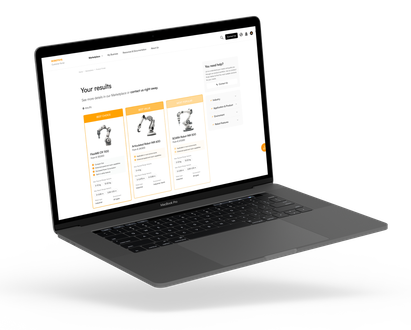
Improved lead qualification so that salespeople no longer have problems distinguishing which customer has what knowledge about company products.
Develop a rapid concept for a partner portal and contribute to securiting a budget for development from high-management.
We have created a place where the B2B customer has a proper description of the products, their dependencies, but also transferred knowledge to eliminate unnecessary questions and shorten the purchase process.
We have created a product configurator that allows advanced customers, engineers, but also partners (such as dealers) to create any robot configuration they wish. This greatly improves workflow, while getting rid of unnecessary and outdated configurators that remember the early 2000s











